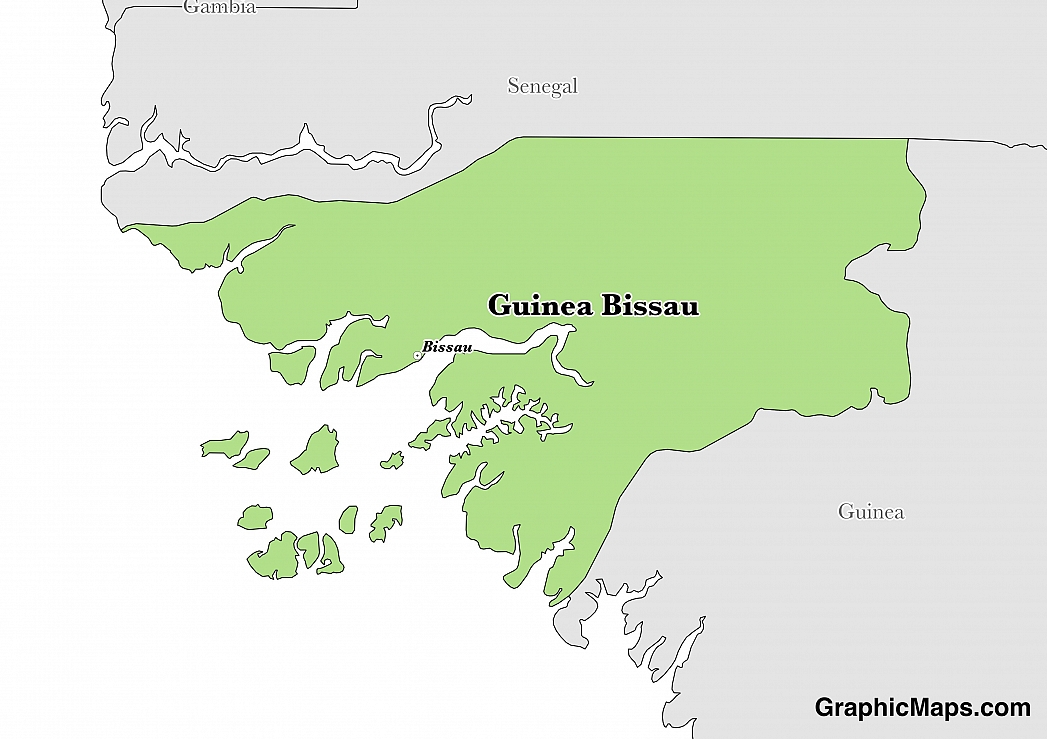Where is Guinea-Bissau?
Located in Western Africa, Guinea-Bissau has a 762.00 km border with Guinea (421 km) and Senegal (341 km). It has a 350.00 km coastline. There is a longstanding low-grade conflict between Guinea-Bissau and parts of Somalia and Liberia.
The capital city of Guinea-Bissau is Bissau. The city is situated on Geba River estuary, off the Atlantic Ocean. Bissau was founded in 1687 by the Portuguese as a trading center and fortified port and became the capital city of Portuguese Guinea in 1942. It became the capital of Guinea-Bissau in 1974, one year after the country’s independence. Bissau is the largest and the most populous city in Guinea-Bissau with a population of approximately 492,000. Although Bissau has suffered the effects of the Civil War and the frequent unrest, it remains an important tourist destination in the country. It has several monuments and museums that are major tourist attractors. Some of the important tourist attractions include the Guinea-Bissau National Art Institute, Bissau French Cultural Center, and Pidjiguiti Memorial. The city experiences a tropical savanna climate. The driest months run from December to April while the remaining months receive a total of 80 inches of rain.
Read more on Guinea-Bissau's CapitalGuinea-Bissau is an African country covering 36,125.00 km2 of which 22.16% is water and 28,120.00 km2 is land. This makes it the 61st smallest country in the world and slightly less than three times the size of Connecticut. Its geographic coordinates are 12 00 N, 15 00 W and Bissau is the capital city.
The country is named for the Guinea region of West Africa.
Its ISO code is GW.
Geography
Guinea-Bissau has a mean elevation of 70 m above sea level.
It has a tropical climate that is hot and humid in the rainy season from June to November and more mild in the dry season of December to May. Its terrain is made up mostly of low-lying coastal plains with savanna in the east.
Population
Guinea-Bissau has a population of 1,759,159 making it the 151st largest in the world.
Crioulo is the lingua franca; Portuguese is the official language. The major ethnic groups reported are Fulani, Balanta, and Mandinga. The majority of the country identifies either with Muslim or Christian beliefs.
The official language of Guinea-Bissau is Portuguese. Portuguese is a West Romance language and part of the Ibero-Romance group that evolved from Vulgar Latin. The language is written with 26 letters of the Latin script and has 21 consonants, nine oral vowels, and two semivowels. Portuguese is spoken by over 220 million people worldwide. In Guinea-Bissau, about 11% of the population speaks Portuguese as the first language while the majority of the rest can somehow sustain a conversation in it. The majority of the Portuguese speakers live in the capital Bissau. The language has been enriched by several loan words from other languages including French and English. Apart from Portuguese, about 23 other languages are spoken in Guinea-Bissau. Of the 23 languages, the widely spoken is the Guinea-Bissau Creole. It is spoken by approximately 44% of the population. Other languages include Balatan, Mandjak, Papel, and Fula. French, English, and Spanish are also spoken in the country, especially by expatriates.
Read more on Guinea-Bissau's LanguagesThe dialing code for the country is 245.
Government
Guinea-Bissau is an independent country. It declared its independence in 1973. Its constitution was last ratified in 1984.
Guinea-Bissau is a semi-presidential representative democratic state with the president and the prime minister as the head of state and government respectively. The executive powers rest on the government while the legislative power is exercised by the parliament and government. The parliament building is located in the capital of Bissau. It was opened in 2004. The official residence of the president is known as the Presidential Palace. It is also located in Bissau and was opened in 2013. The president is elected in a 2-round election while the legislatures are elected directly from 27 constituencies. Two representatives are elected to represent the citizens abroad.
Read more on Guinea-Bissau's GovernmentEconomy
Factoring in Purchasing Power Parity, Guinea-Bissau's GDP is $2,851,000,000.00 (USD) with $1,600.00 (USD) per capita. This makes it the 187th largest economy and its citizens the 206th richest in the world. The currency of Guinea-Bissau is the Franc (XOF).
Its major export partners are India and Nigeria. Its main exports are fish, shrimp, and cashews. Its major import partners are Portugal, Senegal, and China. Its major imports include foodstuffs, machinery and transport equipment, and petroleum products.
Flag
The flag of Guinea-Bissau features the colors of red, black, yellow, and green. The red stripe is vertical while the green and yellow stripes are horizontal. The color of black is implemented in the form of a black star. The flag is in the proportion of 1:2 and was adopted in 1973 following Guinea-Bissau’s independence from the Portuguese.
Read more on Guinea-Bissau's FlagThis page was last modified on January 17th, 2018
More on Graphicmaps

Published on 2019-11-06
What is a Trade Embargo?

Published on 2019-11-04
Which Two Countries Used to Have the Same Flag?

Published on 2019-09-16
What Is the Only Two-Sided State Flag?

Published on 2019-09-16
Which Country Flag Looks Like the Texas Flag?

Published on 2019-08-29
Flags That Resemble the US Flag

Published on 2019-08-20
